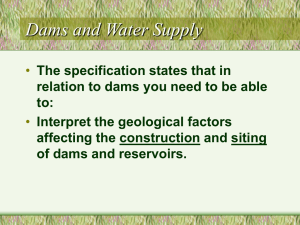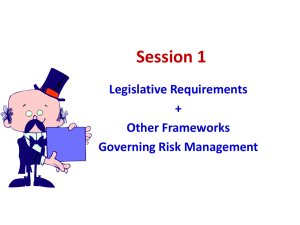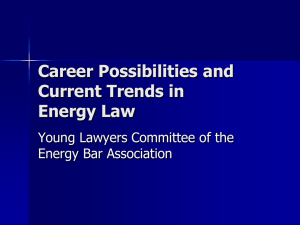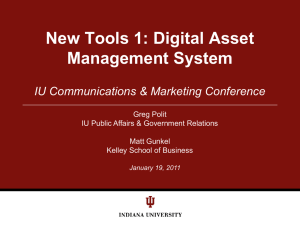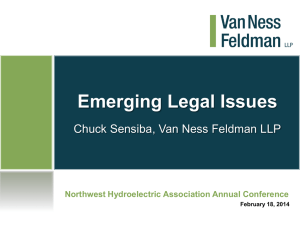Douglas Johnson
advertisement
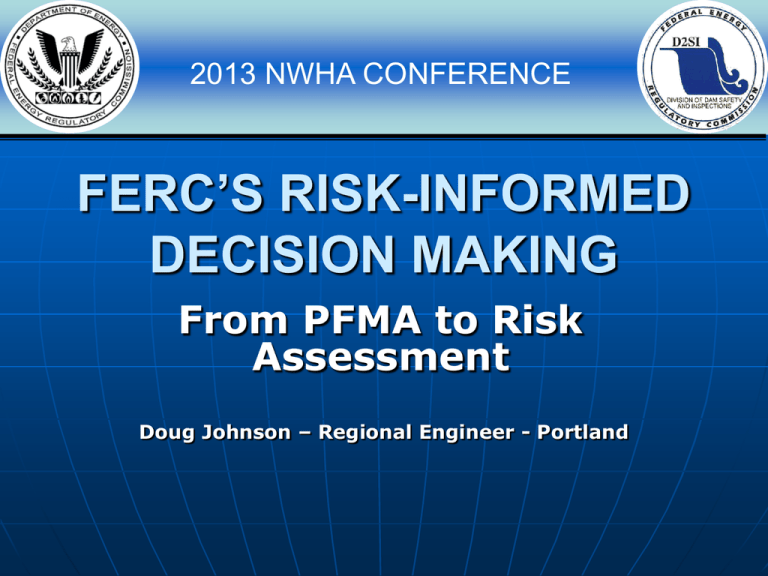
2013 NWHA CONFERENCE FERC’S RISK-INFORMED DECISION MAKING From PFMA to Risk Assessment Doug Johnson – Regional Engineer - Portland 834 High Hazard Potential 234 Significant Hazard Potential In the Beginning… for FERC Risk Assessments begin with a Potential Failure Mode Analysis (PFMA) The FERC first began using risk in a dam safety context in 2003 when it documented the PFMA process into its dam safety guidelines (Chapter 14). PFMA A PFMA is an exercise to • identify all potential failure modes under static loading, normal operating water level, flood, and earthquake conditions including all external loading conditions for water retaining structure • assess those potential failure modes of enough significance to warrant continued awareness and attention to visual observation, monitoring and remediation as appropriate. PFMA (cont.) PFMs are developed by the core team Likely and unlikely factors affecting the chances of occurrence are documented. PFMs are categorized by level of seriousness. PFMA Progress Since the program was initiated all high hazard potential dams have been analyzed. Significant and Low hazard potential dams are still in progress. What is Risk-Informed Decision Making (RIDM) Decision-making, which has as an input the results of a risk assessment. Risk information will play a key role in decisions related to dam safety but will not be the only information to influence the final decisions. RIDM involves a balancing of social and other benefits and the residual risks. Extension of PFMA process PFMAs detail how a dam might fail PFMAs do not directly consider the scope of potential consequences PFMAs do not estimate the likelihood of an adverse event RIDM will consider these items Why Risk? Tolerable Risk Risk society is willing to live with in order to secure certain benefits, Risk society does not regard as negligible or something it might ignore, Risk that society is confident that are being properly managed by the owner, and Risk the owner keeps under review and reduces still further as practicable. Joint Federal Risk Group Includes Reclamation, Army Corps, TVA, FEMA A common federal approach to Risk Standards for risk reduction: Governance vs. Tolerance RIDM Engineering Guidelines 1. Concrete Dams 2. Embankment Dams 3. Internal Erosion and Piping 4. Spillway Gates and Outlet Works 5. Operational Issues, SCADA 6. Hydrologic Hazard Analysis 7. Probable Seismic Hazard Analysis 8. Consequences 9. Risk Analysis 10.Risk Assessment Benefits to Owners and FERC Provides a process to better understand and quantify potential failure modes; Identifies previously unidentified failure modes with high risk, in particular, nontraditional failure modes; Builds on the work completed in PFMAs Provides a means to compare the safety of different dams using a common basis risk; Benefits to Owners and FERC Improves understanding of the uncertainty and variability in traditional analyses; Provides a way to understand the risk associated with a single dam or an entire inventory of dams; Allows evaluation of risk reduction alternatives and effectively reduces the risk regulated dams pose to the public in quantifiable and defensible terms; Focuses resources on those structures that pose the greatest risk. (FERC Strategic Plan) Final Thoughts FERC RIDM program will proceed in parallel with deterministic methods for the near future. Phased approach to implementation. Dams requiring full quantitative risk will be few. In longer run, PFMA process may be expanded to include Qualitative Risk Assessment


